Solutions
How Milwaukee Activists Used Community Organizing to Prevent Slaughterhouse Construction
Food•5 min read
Explainer
Pigs are highly intelligent, social creatures that deserve compassion and respect. They don't deserve to spend their short lives confined to atrocious conditions waiting for imminent slaughter.
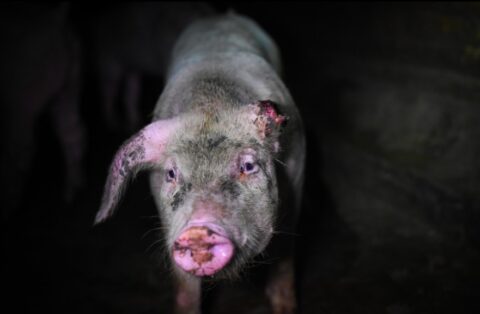

Words by Sentient Media
Pig farming holds many heinous secrets that the pork industry never wants you to hear about.
That’s why it is so difficult to access pig farms to take a look at what’s happening behind the scenes. They simply don’t want you to witness what happens to the millions of pigs that are taken to slaughterhouses to be killed each year.
In fact, there are many ag-gag laws in place to ensure that what is happening behind the walls (and barbwire-laden fences) of pig farms is known by as few people as possible.
Pigs are highly intelligent animals that are remarkably cognizant of their surroundings, and thus, their suffering.
According to neuroscientist Lori Marino of the Nonhuman Rights Project, it’s been shown that “pigs share a number of cognitive capacities with other highly intelligent species such as dogs, chimpanzees, elephants, dolphins, and even humans.”
Pigs are so smart, in fact, that they can recognize other pigs they already know (as opposed to pig “strangers”). They can also form long-term memories and they know which people have treated them well and which haven’t.
The latter point is particularly disheartening considering the amount of abuse that takes place on pig farms all around the globe.
Footage captured at a UK farm in mid-2018 was so horrifying that it got international coverage. Please be warned that the footage below is extremely graphic and upsetting:
How do we let things like this happen?
How are people able to continue eating pork (and meat in general) when this isn’t an exception to the rule but standard practice in countless farms around the world?
And why does one story like this get so much coverage while others don’t?
Is seeing a piglet getting its head smashed against the wall really the bar that society has set when it comes to what’s acceptable and what isn’t with animal abuse?
First off, there is no such thing as “humane” slaughter.
It’s an oxymoron at best. At worst, it’s extremely misleading marketing that allows for dishonest and deceitful labeling.
It’s similar to labeling chickens “free range” because they have “access” to a small hole in the side of a CAFO.
The food industry wants to deceive you. Think about cereal boxes (morning candy) and how much they talk about health and nutrition.
But when it comes to pig farming and the pork industry, the lies have much more serious consequences.
121 million dead pigs to be exact.
And if that number isn’t scary enough for you, that’s just in the US alone.
Not a single one of those pigs were killed in a humane way because such a way doesn’t exist.
Is it possible that some lived better lives than others? Absolutely.
The ones that were raised on small family farms clearly had it better than those raised on factory farms. But their story still ended the same way.
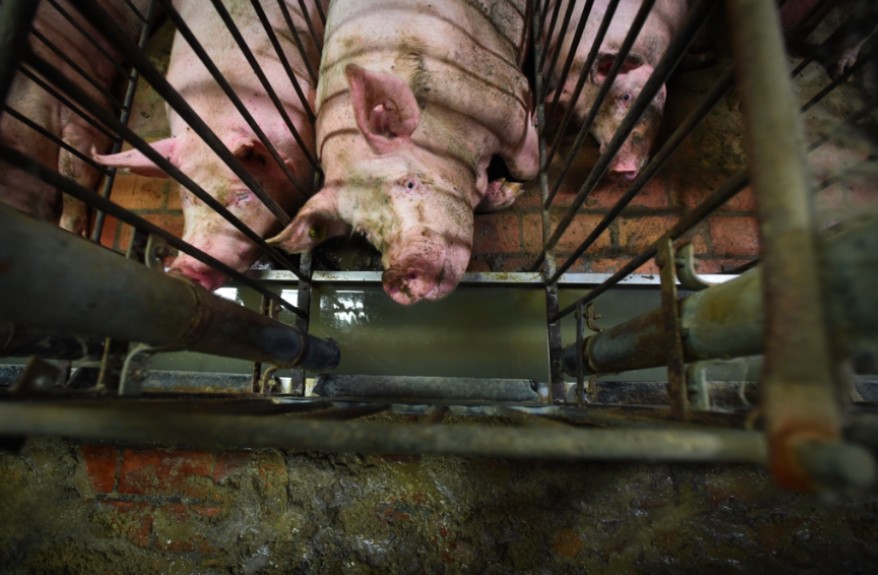
Pig farming is the breeding and raising of pigs with the purpose of harvesting their meat and skin for human consumption and use.
According to the Food and Agriculture Organization, there are just under one billion (986M) pigs alive in the world today living on pig farms.
97% of pigs raised in the United States are confined (and eventually slaughtered) on factory farms.
According to Barry Estabrook, the author of Pigtales, “[The pigs] never see the light of day. They never set foot on anything but a bare, hard floor. They breathe that poisoned air 24/7.”
The United States is third behind only China and the European Union in pork production at 12,166 metric tons in 2018.
And while the US is producing pork at such high rates, take a look at how much is being exported:
So beyond the horrifying details about pig farming that we will discuss in a moment, the food industry is shipping most of the supply abroad, leading to higher rates of food insecurity in the US.
Pig farming supplies the food industry with common products like bacon, sausage, pork chops, salami, ham, and bologna.
These are the products you hear about the most. They are the products most likely to be imitated by plant-based substitutes.
However, gelatin is also made from leftover pig parts and is used in numerous different food products. Many of these products would never be thought of as vegan by those not paying attention. Many candies, ice cream, marshmallows, and jello products contain gelatin.
Pig farming also uses the skin and bladders of pigs in order to create leather products like shoes, footballs, purses, belts, and other accessories. Pigskin is considered “Genuine Leather” on labels.
The truth about pig farming and the atrocities that occur behind the scenes might not surprise you.
If you are part of the animal rights movement in any way, you already know about factory farming. You are already aware that there are horrible living conditions and abuse that run rampant.
But what about the details? What nuances occur on pig farms that might be different on dairy farms or poultry farms?
So how are pigs treated on pork farms?
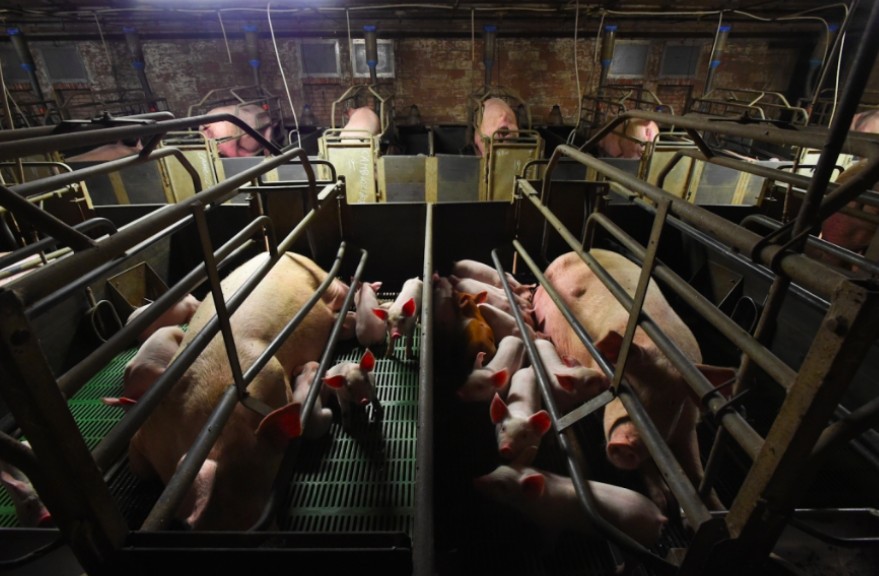
Gestation crates confine mother pigs to a lifetime of immobility and discomfort.
The crates are designed to keep the sows still while pregnant. The sow can wiggle a few inches forward or backward but turning around is impossible.
Sows will spend almost all of their lives pressed between iron. They spent the entirety of their pregnancy behind bars before being moved to farrowing crates.
There, they will nurse their young for very little time before the piglets are torn away. The babies will never see their mothers again. Once separated, the mothers will return to the gestation crates to relive the nightmare over and over again.
This horrifying process lasts for upwards of six gestation periods (on average). She is then deemed unable to continue and is slaughtered.
The pork industry vehemently argues that the crates are comfortable and keep the mother pigs safe. Animal rights activists know better.
Pressure from animal rights groups has definitely helped the cause.
Cargill, one of the largest pork producers in the US, succumbed to public outrage and phased out gestation crates altogether. They opted for “group house” for pregnant sows. While it is an improvement, many pig farmers still use gestation crates and will continue doing so.
After the gestation crate comes the only other space the sow will ever know before slaughter.
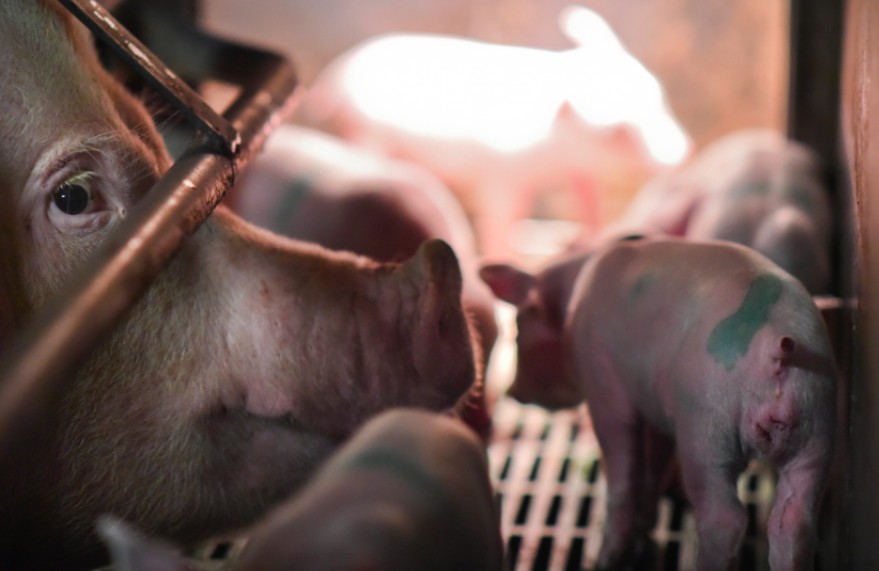
About a week before the mother pig is about to give birth things get even worse for them.
The mother pig is moved from the gestation crate to the farrowing crate. Shockingly, the farrowing crate is even smaller than the gestation crate.
Farrowing crates are typically housed in farrowing sheds where countless mother pigs are confined waiting to give birth.
Factory farms typically squeeze as many farrowing crates into the shed as possible. The idea, as usual, is to maximize space and maximize profits.
Farrowing crates were introduced in the 60s in an effort to try and protect piglets from being crushed by their mothers. While the thought behind the creation was in the right place, the execution lagged in the compassion department.
While the purpose of the crates is to save the piglets, activists have uncovered many cases of piglet mortality due to poor living conditions.
The mother pig will stay in the farrowing crate for approximately four weeks before losing her babies. This will happen twice per year.
Once the mother pig has her babies taken away, she is removed from the farrowing crate and immediately impregnated. This happens about one week after giving birth and losing her offspring.
This process happens through artificial insemination. Then it’s back to the gestation crate again.
On average, a pig’s litter will consist of 10-12 piglets. If the average sow goes through the gestation cycle 6 times, they will have anywhere between 60-72 babies before being sent to slaughter.
Remember, pigs are highly social animals and are cognizant of their relationships.
In nature, a mother pig will search for miles to find the perfect nesting spot for their young. They search high and low for a safe place to raise their piglets. Their maternal instinct is strong and they suffer greatly when separated from their young.
To continually put a mother pig through this amounts to unfathomable cruelty.
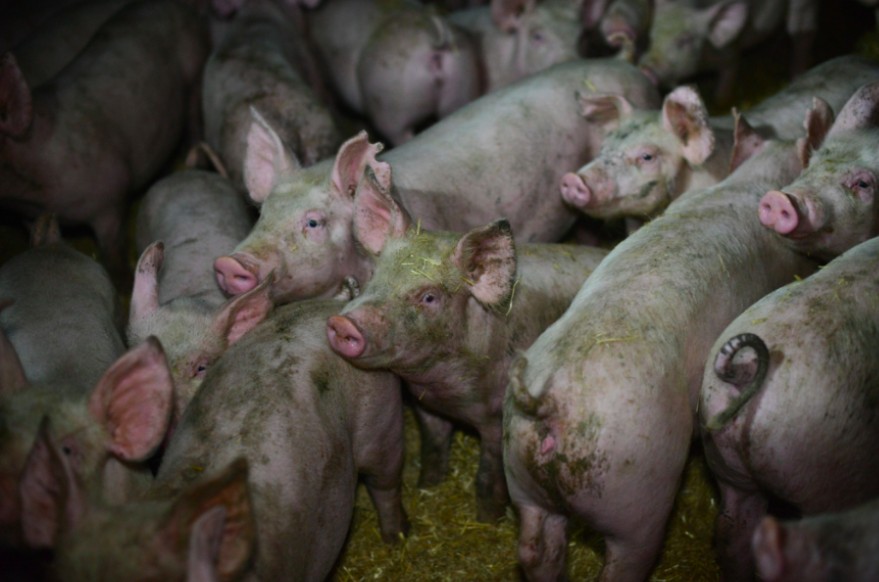
A lot of the time, the piglets are taken away in poor health.
Many piglets aren’t able to get the nutrients they need as they are weaned from their mothers very young. They are typically separated at 21 days of age. Naturally, a piglet would be fully weaned from her mother between 12 and 14 weeks.
Beyond the issue of early separation, many sows suffer from Postpartum Dysgalactia Syndrome (PPDS).
There’s a series of different potential causes for PPDS. Almost all of the causes are related to the living conditions and treatment on factory farms.
The pork industry and pig farmers choose to castrate pigs for different reasons.
Because factory farming is all about efficiency, unwanted pregnancies and an increase in population can cause problems. Factory farms are practically overflowing with livestock as is. An uncontrolled population can make conditions even worse and help spread more disease.
Other reasons why pig farmers choose to castrate is to prevent boar taint in their meat production.
The main reason comes down to control and efficiency. The pork industry is a business and pig farmers want their bottom line to be protected. They don’t see their pigs as sentient beings, rather pegs in the profit-generating machine.
While there are benefits to castrating pigs on factory farms, there is no reason to do it inhumanely.
Mercy for Animals has documented “workers ripping out the testicles of conscious piglets with the use of painkillers.”
Painkillers are not meant to be used as an anesthetic.
In Europe, the Brussels Declaration was put forth to phase out castration without painkillers by 2012 and surgical castration altogether by January 1, 2018. Neither deadline was hit.
Germany has pledged to only castrate piglets proper anesthesia starting in 2019. Only time will tell if they follow through on that promise. If so, it’s a step in the right direction of unnecessary suffering.
However, pig farming is producing a record amount of pork and as populations grow, so will production.
Animal-free farming and clean meat are the only solutions in the foreseeable future.
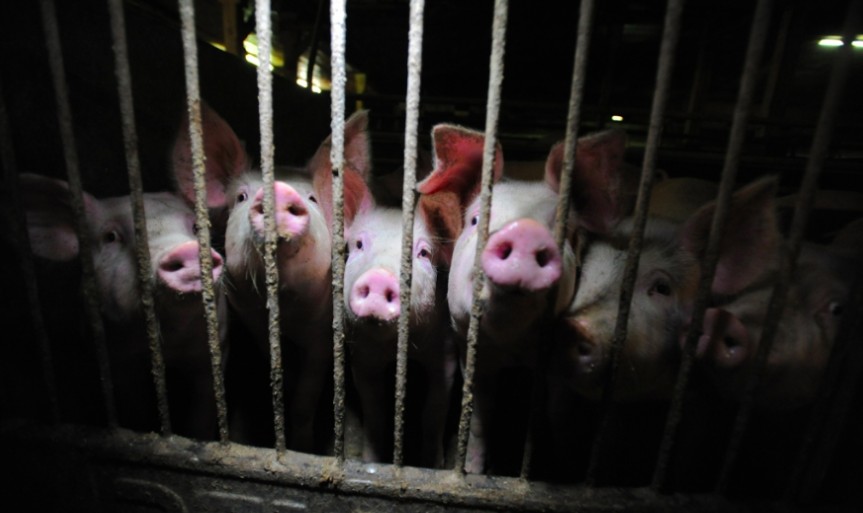
Human animals will never know the extent to which non-human animals suffer.
The disconnect that has stemmed from years of urbanization and food industry marketing has made us numb. Only few can truly accept the idea that all animals have the ability to truly suffer.
There are many problems that stem from a lifestyle of confinement, abuse, and imminent slaughter.
And some of these problems lead to ill-planned and reckless solutions, perpetuated the suffering the pigs face.
Supermarket behemoth Tesco made headlines in 2018 when shocking footage surfaced at a pig farm in England that supplies some of their pork products.
Viva!, an animal welfare group, reported acts of cannibalism due to extreme stress. Cannabilism is not inherent of pigs in nature.
The images were so graphic that most media outlets, including The Daily Mail and some animal rights sites, refused to publish them. We are taking the same route as well as not to distress our readers any further.
Aside from the pigs being cannibalized on this farm, there was news almost as shocking from the same report.
Red Tractor is a seal of approval granted to companies for upholding top-notch farming standards. Their motto is Traceable, Safe, and Farmed With Care.
Hogwood Pig Farm, where Viva! reported pigs being cannibalized, boasts the Red Tractor seal of approval.
What does this say about Red Tractor and the farms that don’t have the seal?
One disturbing behavior found on pig farms and not in nature is tail biting.
Overcrowding and poor living conditions are just some of the factors at play with this abnormal behavior.
The problems with tail biting (and the similar ear biting) go beyond the pain and discomfort. When pigs bite each other’s tails in order to deal with their stressful environment, there can be dire consequences.
Injury and infection just scratch the surface when it comes to what pigs are experiencing when their tails are bitten.
Beyond injury, paralysis or carcass condemnation from spinal abscesses are commonplace on pig farms.
The process of cutting off a pig’s tail in order to prevent tail biting is called tail docking.
Tail docking is performed without anesthesia during the first week of the piglet’s life. Beyond the obvious pain and trauma, the side effects of tail docking in the long term have yet to been studied thoroughly. Acute psychological and behavioral impacts have been observed in the pigs that go through the tail docking process.
The main issue, however, isn’t being addressed.
The pork industry and pig farmers are looking to put a band-aid on a broken leg and avoid the real problem at hand. Factory farming is the issue and it can’t be sidestepped by quick fixes.
Cutting down the teeth of piglets is another ill-concocted, dangerous way of avoiding tail biting.
Some potential side effects of include gum and tongue injuries, abscesses of the teeth, and inflammation.
One study revealed that “both clipping and grinding induce lesions such as pulp cavity opening, fracture, hemorrhage, infiltration or abscess, and osteodentine formation.”
While the intention of clipping the teeth of piglets are to prevent future injuries to the sow and other pigs, again we see that the system in place is the problem and simple workarounds won’t fix the real problems at hand.
Diseases run rampant in pig farming operations. The more animals on site, the more likely it is to have diseases spread around.
On factory farms, pumping pigs full of antibiotics is one of the only ways to avoid the spread of illness. Sick pigs to a farmer equate to more work and a bite out of the profits.
Some of the most common illnesses and diseases on pig farms are the following:
The best way to avoid the spread of disease on pig farms is to adopt better farming practices. When it comes to factory farming, whether for pigs, cows, or chickens, the only way to avoid systemic problems is to change the system. Band-aids on broken legs never do the trick.
Mistreatment and abuse of animals on factory farms are so commonplace that it no longer surprises anyone. Pig farming is no exception. It’s a problem that all animals face with today’s meat industry.
There are so many examples of undercover operations resulting in appalling footage that it no longer shocks people. Most people simply filter out the overwhelming amount of abuse that’s reported on a regular basis.
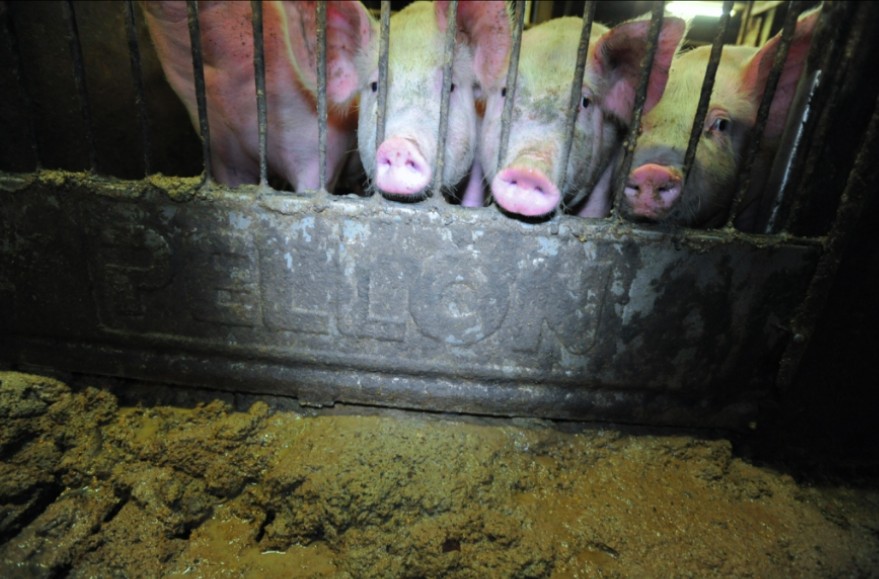
To list all of the instances of the inhumane treatment of pigs would take a lifetime. This is why animal welfare groups and activists are constantly fighting to improve the conditions of pigs on factory farms.
And beyond the stories that are already out there, many haven’t even surfaced yet because of ag-gag laws. Whistleblowers in numerous states are now holding their tongues out of fear of severe punishment.
Smithfield Food, the world’s largest producer of pork, has repeatedly come under fire for inhumane practices.
When they announced back in 2007 that they would be phasing out gestation crates, activists became hopeful that they would lead the way and influence other major corporations and farms.
Although they announced mission accomplished nearly ten years later, undercover activists claim otherwise.
Wayne Hsiung of Direct Action Everywhere said that he and colleagues “absolutely did see mother pigs giving birth in gestation facilities” after infiltrating numerous Smithfield farms.
The major players in the food industry are able to say practically whatever they want. Major producers in the states where ag gag laws have been approved are well protected from whistleblowers speaking out.
Even smaller farms in states where no ag gag laws exist are protected. Simply walking up to the property line of a factory farm has been more than enough to get the police called on activists.
If factory farmers aren’t held accountable, what is the point for them to treat animals more humanely?
It’s easy for individuals to feel that their voice won’t be heard. When going up against major players in the food industry, it’s natural to feel intimidated.
But that doesn’t mean your voice and your choices can’t be a part of the change you desire.
Grassroots movements have changed policy in the past. PETA has spearheaded numerous policy changes in the past that started from the ground up.
Change can happen when there is passion behind actions.
How can you help stop pig farming?
One argument that vegans hear all of the time is that they are making a difference. Many meat eaters are quick to point out that the animals would have died anyway.
But veganism is growing. Becoming a vegan isn’t a passing trend that will soon fade away. The more people that adopt the vegan lifestyle, the lower the demand will be for pig products.
Does this take time? Of course. Change won’t happen overnight. However, the more educated the populace becomes about the cruelties behind pig farming (and factory farming in general), the closer we will come to achieving real change and progress.
While grassroots movements start from the group up, animal rights activists and advocates need to start voting for the right politicians.
People from the movement need to consider running on platforms based on change and animal rights. Policy makers and people in leadership roles do have power and their voices can be influential.
Combining grassroots movements and empowering people with the right mindset is the perfect combination. Doing so can be the trigger necessary to the right kinds of bills and laws that protect animals and their rights.
Getting involved in any way possible is a great way to start. Going vegan is the best first step you can take, taking action is the second.
Volunteer for animal rights groups. Call out animal abuse when you see it. Continuously educate yourself about what’s happening in the animal rights world. Boycott companies that test on animals.
Most importantly: Be vocal.
Pig farming practices treat sentient beings like products. The atrocities behind the pork industry will never stop if people don’t speak up.
Pigs are highly intelligent, social creatures that deserve compassion and respect. They don’t deserve to spend their short lives confined to atrocious conditions waiting for imminent slaughter. No animal deserves this.
Pigs on factory farms suffer greatly and it’s our duty as non-human animals to protect those without a voice. If not, we are complicit in the death of each sentient being.
What are you going to do to help end the cruel practices on pork farms?